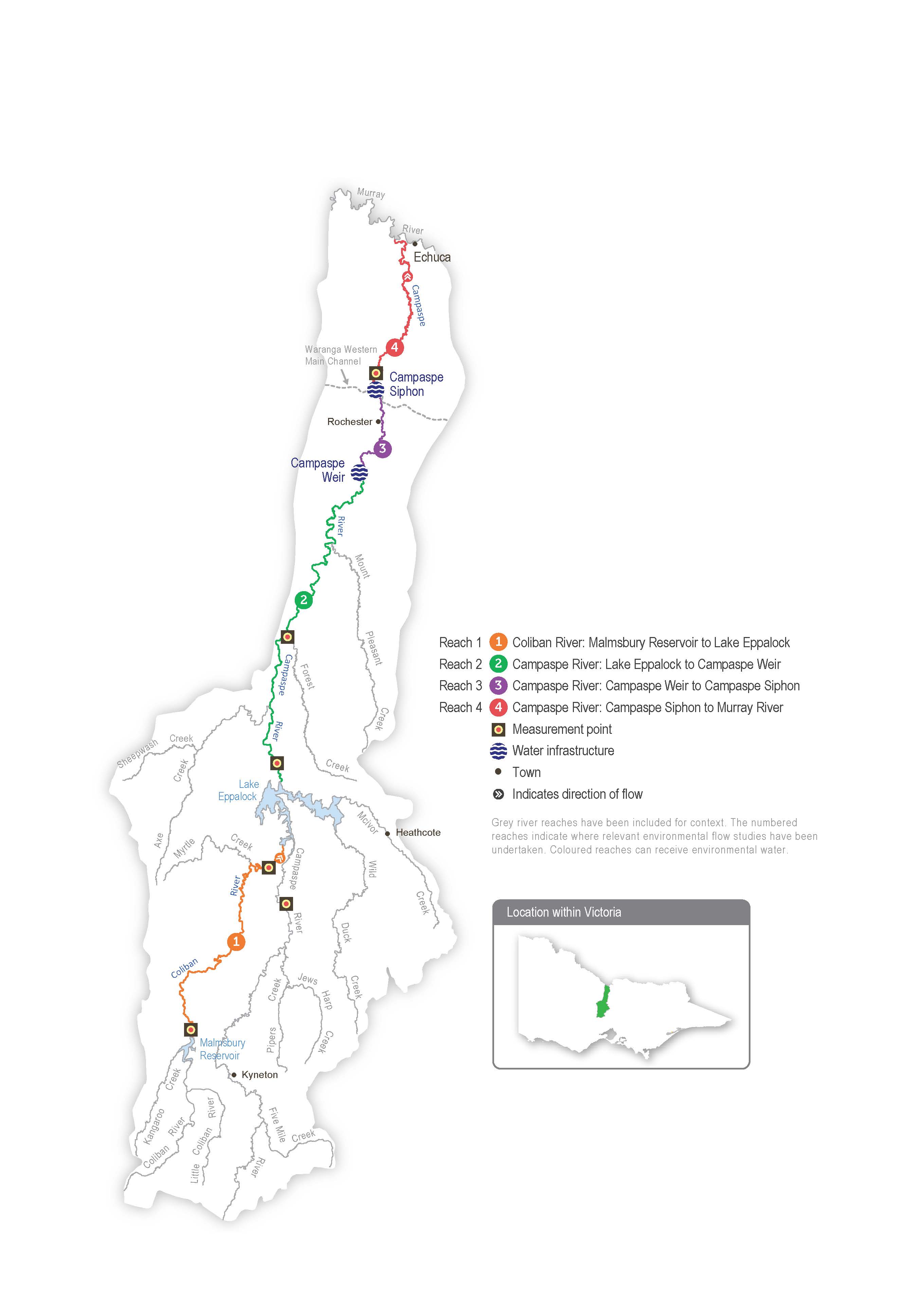On this page:
Latest information about where, when and why environmental water may be delivered to the Campaspe River and the environmental objectives being targeted is available in this year’s seasonal watering plan.
The seasonal watering plan also contains information about how environmental flows could support cultural, social, recreational and economic values in the Campaspe River.
Watering data for the Campaspe River and the wider northern region is updated quarterly. Visit current watering releases to find out more.
To find out the current environmental water entitlements held by the VEWH in the Campaspe River visit our water holdings.
Information about the ownership of water entitlements in the Campaspe River can be found under the Entitlements and Compliance section of the Campaspe basin page at Victorian Water Accounts.
Waterway manager
North Central Catchment Management Authority
Storage manager
Environmental Water Holder
Victorian Environmental Water Holder (including the Living Murray program)
Traditional Owners
Dja Dja Wurrung Clans Aboriginal Corporation has a Recognition and Settlement Agreement with the Victorian Government and is the statutory authority for the management of Aboriginal heritage values and culture, under the Victorian Aboriginal Heritage Act 2006.
Taungurung Land and Waters Council (TLaWC) has a Recognition and Settlement Agreement with the Victorian Government and is the statutory authority for the management of Aboriginal heritage values and culture, under the Victorian Aboriginal Heritage Act 2006.
Yorta Yorta Nation Aboriginal Corporation (YYNAC) is a Registered Aboriginal Party under the Victorian Aboriginal Heritage Act 2006 and has statutory authority for the management of Aboriginal heritage values and culture, under the Victorian Aboriginal Heritage Act 2006.
System overview
Natural inflows in the upper Campaspe River catchment are harvested into Lake Eppalock, located near the townships of Axedale and Heathcote. The main tributaries of the Campaspe River are the Coliban River, McIvor and Wild Duck creeks above Lake Eppalock and Mount Pleasant, Forest and Axe creeks below Lake Eppalock.
Below Lake Eppalock, the major in-stream structure is the Campaspe Weir, built to divert water to the Campaspe Irrigation District. It is no longer used for water diversion but is a barrier to fish migration. Gates on the weir provide some degree of control over the flow, but large flows spill over the weir. The Campaspe Siphon, just below Rochester, is part of the Waranga Western Channel, which carries water from the Goulburn system to western Victoria. Water can be released from the Waranga Western Channel into the lower reaches of the Campaspe River, or water can be pumped from the river into the Waranga Western Channel. The siphon is another barrier to fish migration when there is low-to-moderate flow.
The flow below Lake Eppalock is influenced mainly by releases from storage and the operation of the Campaspe Weir and the Campaspe Siphon. The Campaspe’s major tributary (the Coliban River) flows through the three Coliban Water storages (the Upper Coliban, Lauriston and Malmsbury reservoirs) before reaching Lake Eppalock. Water for the environment is held and released from Lake Eppalock, with some limited ability to regulate the flow further downstream at the Campaspe Weir.
Water for the environment is released from Lake Eppalock to support aquatic plants and animals in and along the Campaspe River. It can be supplemented by water for the environment delivered via the Waranga Western Channel at the Campaspe Siphon, which provides flexibility to meet environmental demands in reach 4. Water for the environment is primarily used in the Campaspe River to improve the magnitude and variability of flow during winter and spring, but it is also used to deliver a critical flow in summer and autumn that is not met or exceeded by operational deliveries. Primary flow measurement points are at Barnadown (reach 2) and below the Campaspe Siphon (reach 4).
Goulburn-Murray Water transfers operational water from Lake Eppalock or through the Waranga Western Channel to Murray River customers and downstream storages (such as Lake Victoria). These inter-valley transfers (IVTs) usually occur in summer and autumn and, depending on the rate of delivery, can either support or compromise environmental flow objectives. High IVT flows delivered when the Campaspe River would naturally have a low flow may reduce suitable habitat for juvenile fish, which rely on protected, shallow areas of water near the edge of the river channel. Sustained high IVT flows in summer can also drown recruiting streamside vegetation. Storage managers and the North Central CMA have been working cooperatively to enhance the positive effects and limit the harmful effects of IVTs on native plants and animals in the Campaspe River. For example, IVTs are sometimes delivered in a pattern that meets summer low-flow and fresh requirements, reducing demand on the environmental entitlement. IVTs have also been released in a pattern to support native fish migration from the Murray River into reach 4 of the Campaspe River without affecting delivery to downstream users.
Environmental values
The Campaspe River below Lake Eppalock provides essential habitat for native fish species, including Murray cod, silver perch, golden perch, Murray-Darling rainbowfish and flat-headed gudgeon. Murray-Darling rainbowfish were presumed lost from the system during the Millennium Drought, but since 2011 they have been recorded at many sites on the Campaspe River. Environmental flows help native fish migrate and disperse throughout the Campaspe system.
Platypus, rakali (water rats), turtles and frogs are also present along the length of the Campaspe River. The narrow streamside vegetation zone is dominated by large, mature river red gum trees supporting wildlife (such as the swift parrot and squirrel glider).
Page last updated: 01/05/25
